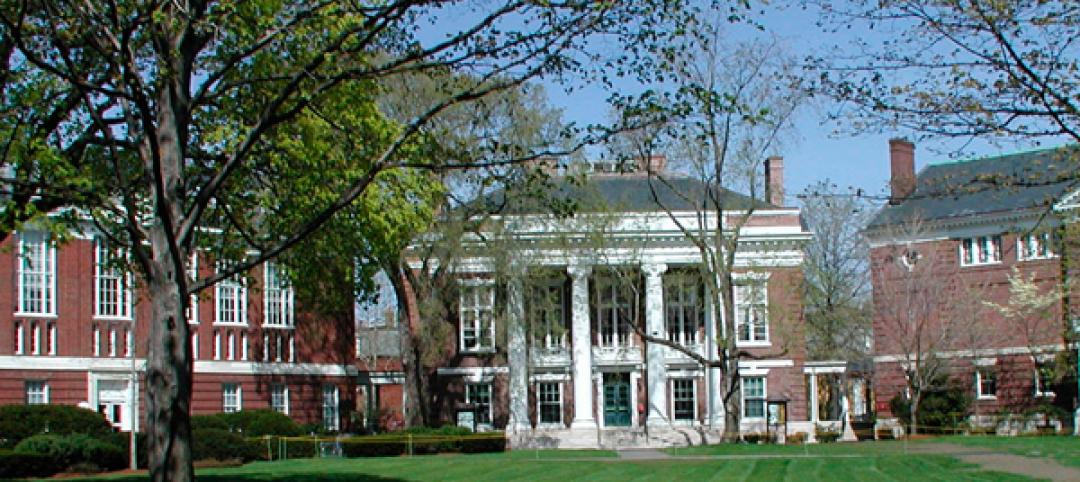Fulton County Schools in Georgia teamed with Georgia Tech’s Center for Education Integrating Science, Mathematics, and Computing (which provided curriculum support) and several other partners to develop Innovation Academy, the school district’s latest magnet school.
The 245,000-sf, three-level school—whose construction began in July 2018 and whose ceremonial groundbreaking occurred last Nov. 22—will be located in downtown Alpharetta, Ga., on property that previously housed the old Milton High School. It will open initially to accommodate ninth and 10th graders, but ultimately will serve between 1,500 and 1,600 students in grades nine through 12.
To support the workforce needs of the North Fulton community, the school’s curriculum will focus on Information Technology, Engineering, and Health Sciences, with an emphasis on design thinking and preparing students for a “knowledge economy.” Learning will be demonstrated through projects, portfolios, certifications, business mentorships as well as student created applications and products.
Innovation Academy will take academic concepts and teach them through real-world experiences and hands-on problem solving. Students will work in teams with support from a robust advisory program, with the goal of cultivating the students to become future leaders who can help solve the community’s challenges.
Atlanta-based design firm Cooper Carry brought together its K-12, Higher Education, and Science & Technology studios to collaborate on the design of Innovation Academy, which is centered around a three-story atrium dubbed Touchdown Commons that runs through the building’s spine and will serve as the school’s cafeteria and media center.
This multifunctional space will be outfitted with moveable seating and accessible technology to create an environment suitable for everything from eating lunch to robotics practice. The communal area is designed to connect with an outdoor courtyard and makerspace that’s visible through windows that allow for natural light to come into the classrooms.
Inside, the school’s corridor walls will be manufactured from a combination of glass windows and garage doors to promote transparency. Interior dividers will be made from stud walls. The school’s rooms will be constructed using a planning module with multiples of the same 11-ft wide by 30-ft deep configuration, to allow for user flexibility.
The building’s exterior brick and columns are designed to match the look of Alpharetta City Center, a 26-acre mixed use property that expanded the city’s downtown by six blocks and includes the Cooper Carry-designed Alpharetta City Library, which opened five years ago.

The three-story atrium in Innovation Academy, known as Touchdown Commons, will be a multifunctional space that connects to an outdoor courtyard.
The design plans for Innovation Academy were informed by public outreach sessions with the school’s faculty and local community members.
Cooper Carry is also working with Fulton County Schools to develop a sister STEM school in Fairburn, Ga., which could open during the 2021-22 school year.
Jacobs is the project manager and Barton Malow the GC on Innovation Academy, which is scheduled to open in August 2021, a year later than originally planned.
Superintendent Mike Looney told the Atlanta Journal Constitution last June that his staff needed more time to prepare before the school opened. “I want to ensure that there is a comprehensive educational structure in place before we recruit and place students in this program,” he stated. “If we want students to join a new effort like this, they and their parents deserve a comprehensive and detailed picture of what they will learn as part [of] this experience and how that experience will prepare them for college and a career.”
Indeed, next year Innovation Academy will be used as a hub for teacher and staff training.
Related Stories
| Aug 8, 2013
Energy research animates science sector [2013 Giants 300 Report]
After an era of biology-oriented spending—largely driven by Big Pharma and government concerns about bioterrorism—climate change is reshaping priorities in science and technology construction.
| Aug 8, 2013
Top Science and Technology Sector Engineering Firms [2013 Giants 300 Report]
Affiliated Engineers, Middough, URS top Building Design+Construction's 2013 ranking of the largest science and technology sector engineering and engineering/architecture firms in the U.S.
| Aug 8, 2013
Top Science and Technology Sector Architecture Firms [2013 Giants 300 Report]
HDR, Perkins+Will, HOK top Building Design+Construction's 2013 ranking of the largest science and technology sector architecture and architecture/engineering firms in the U.S.
| Aug 8, 2013
Top Science and Technology Sector Construction Firms [2013 Giants 300 Report]
Skanska, DPR, Suffolk top Building Design+Construction's 2013 ranking of the largest science and technology sector contractors and construction management firms in the U.S.
| Aug 6, 2013
Renovation of Radcliffe Institute for Advanced Study yields oldest LEED-certified building in U.S.
The Radcliffe Institute for Advanced Study recently achieved LEED-NC v3 Gold certification for its renovation of the historic Fay House, making it the oldest LEED-certified building in the United States.
| Jul 31, 2013
15 innovations impacting higher education
Colleges must become more nimble, entrepreneurial, student-focused, and accountable for what students learn, according to Steven Mintz, Executive Director of the University of Texas system’s Institute for Transformational Learning. Mintz offers 15 innovations in higher education.
| Jul 29, 2013
2013 Giants 300 Report
The editors of Building Design+Construction magazine present the findings of the annual Giants 300 Report, which ranks the leading firms in the AEC industry.
| Jul 25, 2013
First look: Studio Gang's residential/dining commons for University of Chicago
The University of Chicago will build a $148 million residence hall and dining commons designed by Studio Gang Architects, tentatively slated for completion in 2016.
| Jul 22, 2013
School officials and parents are asking one question: Can design prevent another Sandy Hook? [2013 Giants 300 Report]
The second deadliest mass shooting by a single person in U.S. history galvanizes school officials, parents, public officials, and police departments, as they scrambled to figure out how to prevent a similar incident in their communities.
| Jul 22, 2013
Competitive pressures push academia to improve residences, classrooms, rec centers [2013 Giants 300 Report]
College and university construction continues to suffer from strained government spending and stingy commercial credit.

















